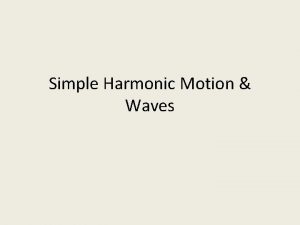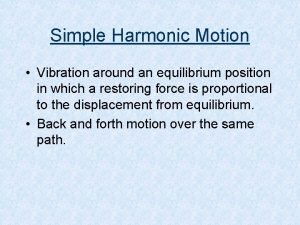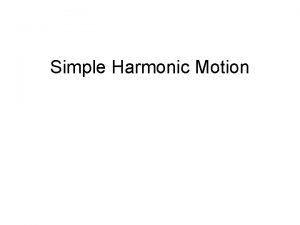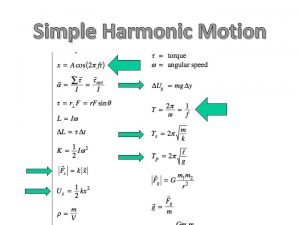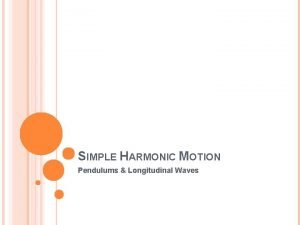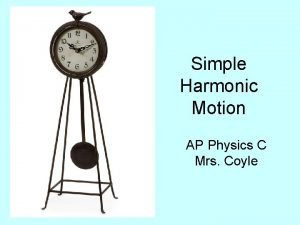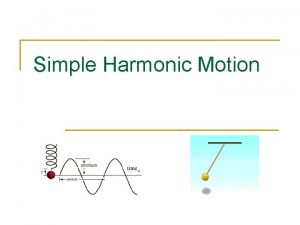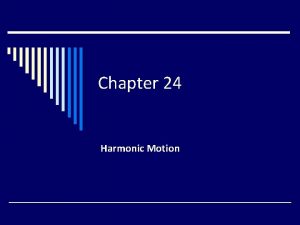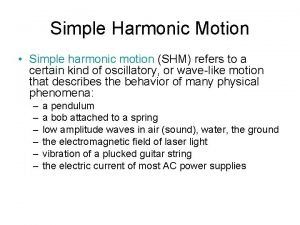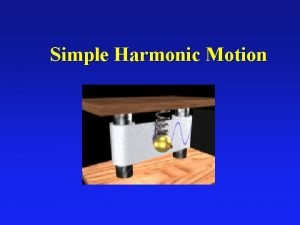CHAPTER15 Oscillations Ch 15 2 Simple Harmonic Motion



![Ch 15 -2 Simple Harmonic Motion The Velocity of SHM V(t)=dx/dt= d/dt[xmcos( t+ )] Ch 15 -2 Simple Harmonic Motion The Velocity of SHM V(t)=dx/dt= d/dt[xmcos( t+ )]](https://slidetodoc.com/presentation_image_h2/42e0226845d4fb329bc613ea548dd392/image-4.jpg)





- Slides: 9

CHAPTER-15 Oscillations

Ch 15 -2 Simple Harmonic Motion (Oscillatory motion) back and forth periodic motion of a particle about a point (origin of an axis). Frequency f: Number of oscillations completed each second Period of the motion T= 1/f Displacement x of the particle about the origin is a sinusoidal function of time t given by : x(t)=xmcos( t+ ) = 2 f = 2 /T

Ch 15 -2 Simple Harmonic Motion
![Ch 15 2 Simple Harmonic Motion The Velocity of SHM Vtdxdt ddtxmcos t Ch 15 -2 Simple Harmonic Motion The Velocity of SHM V(t)=dx/dt= d/dt[xmcos( t+ )]](https://slidetodoc.com/presentation_image_h2/42e0226845d4fb329bc613ea548dd392/image-4.jpg)
Ch 15 -2 Simple Harmonic Motion The Velocity of SHM V(t)=dx/dt= d/dt[xmcos( t+ )] v(t)=dx/dt=- xm sin( t+ ) v(t)= =-vmsin( t+ ) vm is maximum value of velocity and is called velocity amplitude The Acceleration of SHM a(t)=dv/dt= d/dt[- xm sin( t+ )] a(t)=- 2 xm cos( t+ )=- 2 x In SHM a(t)=- 2 x a(t) -x

Ch 15 -3 Force Law for Simple Harmonic Motion Force Required for SHM F=ma =m(- 2 x)=-(m 2)x=-kx familiar restoring force of Hook’s law: Spring force with spring constant k= m 2 Block-spring system forms linear simple harmonic oscillator with angular frequency = (k/m) ; Oscillation Period T=2 / = 2 (m/k)

Ch 15 -4 Energy in Simple Harmonic Motion v Mechanical Energy E of a Simple Harmonic Oscillator: v E = K(t) +U(t), where K(t) and U(t) are kinetic and potential energies of the oscillator given by: v K(t)=mv 2/2=[m 2 x 2 m sin 2( t+ )]/2 v =[kx 2 m sin 2( t+ )]/2 v U(t)=kx 2/2=[kx 2 m cos 2( t+ )]/2 v E=K(t)+U(t) = kx 2 m /2

Ch 15 -5 An Angular Simple Harmonic Oscillator v Torsion Pendulum ü Disk of the pendulum oscillates in a horizontal plane with a restoring torque =- ü Then equation T=2 (m/k) ü modifies to T=2 (I/ ) , where I is moment of inertia and is torsion constant

Ch 15 -6 Pendulums • The Simple Pendulum consists of a particle of mass m (called bob of the pendulum) suspended from one end of an unstretchable, massless string of length L. The bob back and forth motion under a restoring torque ( =r F). Then = -LFgsin =-Lmgsin = I ; For small values of , sin = Then I = =-Lmg and = -(Lmg/I) =- 2 ; 2 = L mg/I T=2 / = 2 (I/Lmg). For a simple pendulum I=m. L 2; T=2 (L/g)

Ch 15 -6 Pendulums v The Physical Pendulum v For a physical pendulum , the period T=2 / = 2 (I/mgh) v where h is distance of center of mass from pivot point. v For a meterstick pivoted at one end I=ML 2/3 and h=L/2 v T=2 (2 L/3 g)
 What is the formula of simple harmonic motion
What is the formula of simple harmonic motion First harmonic and second harmonic
First harmonic and second harmonic Simple harmonic motion vocabulary
Simple harmonic motion vocabulary The highest point above the equilibrium position
The highest point above the equilibrium position How to find the restoring force of a spring
How to find the restoring force of a spring Shm reference circle
Shm reference circle Simple harmonic motion formula
Simple harmonic motion formula Harmonic motion examples
Harmonic motion examples Shm
Shm Frequency of oscillation
Frequency of oscillation


